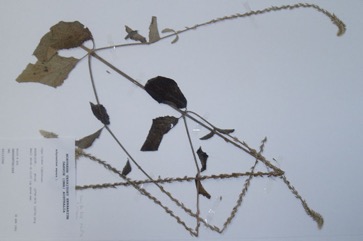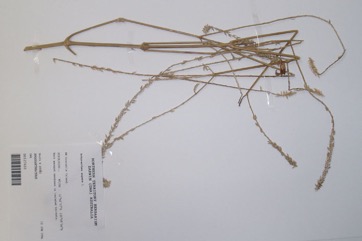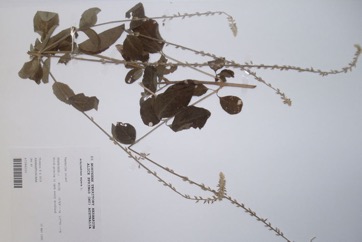Chaff-flower, Rough chaff tree

A tropical plant. A native plant of tropical areas. It occurs in waste places at low and medium altitudes in the Philippines. It grows in northern Australia. It prefers moist well drained soils. It can grow in a partly shaded position but is most commonly in full sunshine. It is drought and frost tender. It does best in soils with high organic matter but can grow in sandy areas. It can grow in arid places. It has become common in Papua New Guinea in low altitudes in areas with seasonal climates. It Java it grows up to 300 m above sea levels. In Tanzania it grows up to 3,000 m above sea level and in areas with 700-1,300 mm rainfall.
Also known as:
Aga, Aghadha, Agharda, Aghedo, Agudha, Akamaro, Amazinycenja, Apamarga, Apamaranga, Apang, Apangshak, Ara songsang, Athian alur, Ato ite oryang, Bantjen, Chirchita, Co suot, Daun inget, Jarongan, Jercok, Kalamata, Kasita, Katalati, Kulbek, Kyet-mauk-pyan, Kyet-mauk-sue-pyan, Latjira, Layobe, Lenamo, Landklits, Mukuluvhali, Naagar, Nairusedi keerai, Naukpo, Nayurivi, Nayuruvi, Ngwirisi ndi kakose, Nta basimane, Nyarang sunsang, Obhat kata, Puthkanda, Rag-ragadi, Sangketan, Sisi vao, Suga-dugodok, Tamatama, Tsipolomanitra, Tu niu xi, Tǔniúxī, Ulti hot, Umdombe, landigasepu, UtbUthareni, Uttarane, Uttaren, Uthrani soppu, Uttreni, Valiyakadaladi
Synonyms
- Achyranthes canescens R.Br.
- Achyranthes robusta C. H. Wright
- and others
Edible Portion
- Leaves, Flowers, Seeds, Vegetable
Where does Chaff-flower grow?
Found in: Afghanistan, Africa, American Samoa, Americas, Angola, Asia, Australia, Bangladesh, Benin, Bhutan, Botswana, Burkina Faso, Cambodia, Cameroon, Caroline Islands, Central Africa, Chad, China, Congo, Dominican Republic, East Africa, East Timor, Egypt, Eritrea, Eswatini, Ethiopia, Fiji, Gabon, Greater Antilles, Guianas, Guinea, Guinée, Guinea-Bissau, Haiti, Hawaii, Himalayas, India, Indochina, Indonesia, Kenya, Laos, Lesser Antilles, Madagascar, Malawi, Malaysia, Marquesas, Micronesia, Mozambique, Myanmar, Nepal, New Caledonia, Nigeria, Norfolk Island, North Africa, Northeastern India, Pacific, Pakistan, Palau, Papua New Guinea, PNG, Philippines, Rotuma, Sao Tome and Principe, SE Asia, Senegal, Sierra Leone, Slovenia, Somalia, South Africa, Southern Africa, South America, South Sudan, Spain, Sri Lanka, St Helena, Swaziland, Tanzania, Thailand, Timor-Leste, Tonga, Tuvalu, Uganda, Vietnam, Wallis and Futuna, West Africa, West Indies, Zambia, Zimbabwe
Notes: This one is used as medicine in Nepal. It has some anticancer properties. There are 6 Achyranthes species. The grow in tropical and warm temperate regions.
Status: It is used as a famine food in a range of countries. It is not known if it is eaten in PNG. It is sold in local markets in China.
Growing Chaff-flower, Rough chaff tree
Cultivation: It is grown by seed.
Edible Uses: The young leaves and seeds are cooked and eaten. They are boiled without salt.
Nutrition Info
per 100g edible portion| Edible Part | Energy (kcal) | Protein (g) | Iron (mg) | Vitamin A (ug) | Vitamin c (mg) | Zinc (mg) | % Water |
|---|---|---|---|---|---|---|---|
| Leaves | 93 | 5.3 | - | 43 | 20 | - | 70.6 |
| Seeds | 42 | 4.3 | - | - | - | - | 83.9 |
| Flowers | 46 | 6.4 | - | - | - | - | 85 |
Chaff-flower, Rough chaff tree Photos



References
Achigan-Dako, E. G., et al, (Eds.), 2010, Traditional vegetables in Benin. Institut National des Recherches Agricoles du Bénin. Imprimeries du CENAP, Cotonou.
Ambasta S.P. (Ed.), 2000, The Useful Plants of India. CSIR India. p 10
Bao Bojian; Steve Clemants, Thomas Borsch, Amaranthaceae [Draft], Flora of China
Behera, K. K. et al, 2008, Wild Edible Plants of Mayurbhanj District, Orissa, India. J. Econ. Taxon. Bot. Vol. 32 (Suppl,) pp 305-314
BHANDARI,
Bhaskarachary, K., et al, 1995, Carotene content of some common and less familiar foods of plant origin. Food Chemistry 54: 189-193
Bircher, A. G. & Bircher, W. H., 2000, Encyclopedia of Fruit Trees and Edible Flowering Plants in Egypt and the Subtropics. AUC Press. p 7
Bodkin, F., 1991, Encyclopedia Botanica. Cornstalk publishing, p 44
Burkill, H. M., 1985, The useful plants of west tropical Africa, Vol. 1. Kew.
Burkill, I.H., 1966, A Dictionary of the Economic Products of the Malay Peninsula. Ministry of Agriculture and Cooperatives, Kuala Lumpur, Malaysia. Vol 1 (A-H) p 33
Borrell, O.W., 1989, An Annotated Checklist of the Flora of Kairiru Island, New Guinea. Marcellin College, Victoria Australia. p 47
Checklist of NT Vascular Plant Species. January 2003.
Cooper, W. and Cooper, W., 2004, Fruits of the Australian Tropical Rainforest. Nokomis Editions, Victoria, Australia. p 14
Cowie, I, 2006, A Survey of Flora and vegetation of the proposed Jaco-Tutuala-Lore National Park. Timor-Lests (East Timor) www.territorystories.nt/gov.au p 42
Cribb, A.B. & J.W., 1976, Wild Food in Australia, Fontana. p 115
Cunningham, 1985,
Devarkar, V. D., et al, 2011, Dietary and Medicinal Significance of Wild Vegetables from Osmanabad Region, Maharashtra (India). Life sciences Leaflets 11:317-332.
Dey, A. & Mukhererjee, A., 2015, Living and Survival Amidst Hunger: Wild Edible Botanicals as a Prime Forest Productivity in the Rural Purulia District, West Bengal, India from Colonial to Present. Research Journal of Forestry 9(3): 71-86
Facciola, S., 1998, Cornucopia 2: a Source Book of Edible Plants. Kampong Publications, p 8
Flora of Australia Volume 49, Oceanic Islands 1, Australian Government Publishing Service, Canberra. (1994) p 88
Fowler, D. G., 2007, Zambian Plants: Their Vernacular Names and Uses. Kew. p 6
Fox, F. W. & Young, M. E. N., 1982, Food from the Veld. Delta Books. p 70
Franklin, J., Keppel, G., & Whistler, W., 2008, The vegetation and flora of Lakeba, Nayau and Aiwa Islands, Central Lau Group, Fiji. Micronesica 40(1/2): 169–225, 2008
GAMMIE;
Grivetti, L. E., 1980, Agricultural development: present and potential role of edible wild plants. Part 2: Sub-Saharan Africa, Report to the Department of State Agency for International Development. p 49
Grubben, G. J. H. and Denton, O. A. (eds), 2004, Plant Resources of Tropical Africa 2. Vegetables. PROTA, Wageningen, Netherlands. p 559
GUPTA & KANODIA,
Harisha, R. P. & Padmavathy, S., 2013, Knowledge and Use of Wild Edible Plants in Two Communities in Malai Madeshwara Hills, Southern India. International Journal of Botany 9(2): 64-72.
Henty, E.E., & Pritchard, G.S., 1973, Weeds of New Guinea and their control. Botany Bulletin No 7, Division of Botany, Lae, PNG. p 55
Hiddins, L., 1999, Explore Wild Australia with the Bush Tucker Man. Penguin Books/ABC Books. p 134
Hossain, U. & Rahman, A., 2018, Study and quantitative analysis of wild vegetable floral diversity available in Barisal district, Bangladesh. Asian J. Med. Biol. Res. 2018, 4 (4), 362-371
Jan, M., et al, 2018, Ethnobotanical Study of Plants Used By Ethnic People of Karbari Grant Village Dehradun, Uttarakhand. SERBD-International Journal of Multidisciplinary Sciences
Jardin, C., 1970, List of Foods Used In Africa, FAO Nutrition Information Document Series No 2.p 51
Karthi, Sathya, & Salome, 2014, Uncultivated Edible Greens from Small Millet Farms Tamil Nadu India. IDRC
Kenneally, K.E., Edinger, D. C., and Willing T., 1996, Broome and Beyond, Plants and People of the Dampier Peninsula, Kimberley, Western Australia. Department of Conservation and Land Management. p 54
Khan, M. & Hussain, S., 2014, Diversity of wild edible plants and flowering phenology of district Poonch (J & K) in the northwest Himalaya. Indian Journal of Sci, Res. 9(1): 032-038
Kuhnlein, H. V., et al, 2009, Indigenous Peoples' food systems. FAO Rome p 191
Kumar, S. A., Manus, D. & Mallika, M., 2018, Impact of non-timber forest products on Forest and in Livelihood Economy of the People of Adjoining Areas of Jalpaiguri Forest Division, West Bengal, India. Int. J. of Life Sciences, 2018; 6 (2):365-385
Lazarides, M. & Hince, B., 1993, Handbook of Economic Plants of Australia, CSIRO. p 8
Levitt, D., 1981, Plants and people. Aboriginal uses of plants on Groote Eylandt, Australian Institute of Aboriginal Studies, Canberra. p 80
Li, D. et al, 2017, Ethnobotanical survey of herbal tea plants from the traditional markets in Chaoshan, China. Journal of Ethnopharmacology. 205 (2017) 195-206
Long, C., 2005, Swaziland's Flora - siSwati names and Uses http://www.sntc.org.sz/flora/
Macmillan, H.F. (Revised Barlow, H.S., et al), 1991, Tropical Planting and Gardening. Sixth edition. Malayan Nature Society. Kuala Lumpur. p 356
Magwede, K., van Wyk, B.-E., & van Wyk, A. E., 2019, An inventory of Vhavenḓa useful plants. South African Journal of Botany 122 (2019) 57–89
Manandhar, N.P., 2002, Plants and People of Nepal. Timber Press. Portland, Oregon. p 68
Martin, F.W. & Ruberte, R.M., 1979, Edible Leaves of the Tropics. Antillian College Press, Mayaguez, Puerto Rico. p 172
Masters, T., 2021, Traditional food plants of the upper Aswa River catchment of northern Uganda—a cultural crossroads. Journal of Ethnobiology and Ethnomedicine (2021) 17:24
McMakin, P.D., 2000, Flowering Plants of Thailand. A Field Guide. White Lotus. p 87
Monsalud, M.R., Tongacan, A.L., Lopez, F.R., & Lagrimas, M.Q., 1966, Edible Wild Plants in Philippine Forests. Philippine Journal of Science. p 436
Mot So Rau Dai an Duoc O Vietnam. Wild edible Vegetables. Ha Noi 1994, p 28
Narayanan Ratheesh, M. K. et al, 2011, Wild edible plants used by the Kattunaikka, Paniya and Kuruma tribes of Wayanad District, Kerala, India. Journal of Medicinal Plants Research Vol. 5(15), pp. 3520-3529
Ochse, J.J. et al, 1931, Vegetables of the Dutch East Indies. Asher reprint. p 10
Paczkowska, G. & Chapman, A.R., 2000, The Western Australian Flora. A Descriptive Catalogue. Western Australian Herbarium. p 136
Pandy, R. K. & Saini, S. K., 2007, Edible plants of tropical forests among tribal communities of Madhya Pradesh. Indian Journal of Traditional Knowledge. 6(1), pp 185-190
Pagag, K. & Borthakur, S. K., 2012, Wild edible wetland plants from Lakhimpur district of Assam, India. Pleione 6(2): 322 - 327. 2012.
Patiri, B. & Borah, A., 2007, Wild Edible Plants of Assam. Geethaki Publishers. p 106
Peekel, P.G., 1984, (Translation E.E.Henty), Flora of the Bismarck Archipelago for Naturalists, Division of Botany, Lae, PNG. p 170, 171
Peters, C. R., O'Brien, E. M., and Drummond, R.B., 1992, Edible Wild plants of Sub-saharan Africa. Kew. p 46
Pham-Hoang Ho, 1999, An Illustrated Flora of Vietnam. Nha Xuat Ban Tre. p 730
Pickering, H., & Roe, E., 2009, Wild Flowers of the Victoria Falls Area. Helen Pickering, London. p 20
Plants of Haiti Smithsonian Institute http://botany.si.edu
Rajkalkshmi, P. et al, 2001, Total carotenoid and beta-carotene contents of forest green leafy vegetables consumed by tribals of south India. Plant Foods for Human Nutrition 56:225-238
Ramachandran, V. S., 2007, Wild edible plants of the Anamalais, Coimbatore district, western Ghats, Tamil Nadu. Indian Journal or Traditional Knowledge. 6(1) pp 173-176
Reddy, K. N., et al, 2006, Traditional knowledge on wild food plants in Andhra Pradesh. Indian Journal of Traditional Knowledge 6(1) pp 223-229
Ruiters-Welcome, A. K., 2019, Food plants of southern Africa. Ph.D. thesis. Univ. of Johannesburg p 9
Roodt, V., 1998, Common Wild Flowers of the Okavango Delta. Medicinal Uses and Nutritional value. The Shell Field Guide Series: Part 2. Shell Botswana. p 13
Royal Botanic Gardens, Kew (1999). Survey of Economic Plants for Arid and Semi-Arid Lands (SEPASAL) database. Published on the Internet; http://www.rbgkew.org.uk/ceb/sepasal/internet [Accessed 24th March 2011]
Ruffo, C. K., Birnie, A. & Tengnas, B., 2002, Edible Wild Plants of Tanzania. RELMA p 98
Ruiters-Welcome, A. K., 2019, Food plants of southern Africa. Ph.D. thesis. Univ. of Johannesburg p 9 (As Achyranthes robusta)
Sarma, H., et al, 2010, Updated Estimates of Wild Edible and Threatened Plants of Assam: A Meta-analysis. International Journal of Botany 6(4): 414-423
SAXENA;
Scudder, 1962,
Seidemann J., 2005, World Spice Plants. Economic Usage, Botany, Taxonomy. Springer. p 4
Shackleton, S. E., et al, 1998, Use and Trading of Wild Edible Herbs in the Central Lowveld Savanna Region, South Africa. Economic Botany, Vol. 52, No. 3, pp. 251-259 (As Achyranthes robusta)
SHANKARNARAYAN & SAXENA,
SHORTT,
Siemonsma, J. S. & Kasem Piluek, eds. 1993. Vegetables. In: Plant Resources of South-East Asia (PROSEA) 8:311
Singh, A., 2009, Bioactivity of Famine Food Plants from the family: Amaranthaceae. University of Technology, Durban, South Africa. Masters Degree Thesis. p 1-116
Singh, G. K. & Ahirwar, R. K., 2013, An Ethnobotanical Survey for Certain Wild Edible Plants of Chanda Forest District Dindori Central India. International Journal of Science and Research. 6:14
Singh, H.B., Arora R.K.,1978, Wild edible Plants of India. Indian Council of Agricultural Research, New Delhi. p 39, 82
Smith, A.C., 1981, Flora Vitiensis Nova, Lawaii, Kuai, Hawaii, Volume 2 p 290
Sp. pl. 1:204. 1753
Swaziland's Flora Database http://www.sntc.org.sz/flora
Thaman, R. R, 2016, The flora of Tuvalu. Atoll Research Bulletin No. 611. Smithsonian Institute p 60
Thiselton-Dywer, W.T., (Ed.), 1913, Flora of Tropical Africa. Vol VI-section 1. Reeve, p 65
Tredgold, M.H., 1986, Food Plants of Zimbabwe. Mambo Press. p 32
Tsering, J., et al, 2017, Ethnobotanical appraisal on wild edible plants used by the Monpa community of Arunchal Pradesh. Indian Journal of Traditional Knowledge. Vol 16(4), October 2017, pp 626-637
Usher, G., 1974, A Dictionary of Plants Used by Man. Constable. p 16
Vernon, R., 1983, Field Guide to Important Arable Weeds of Zambia. Dept of Agriculture, Chilanga, Zambia. p 24
von Katja Rembold, 2011, Conservation status of the vascular plants in East African rain forests. Dissertation Universitat Koblenz-Landau
WATT.
Kanis, A in Womersley, J.S., (Ed), 1978, Handbooks of the Flora of Papua New Guinea. Melbourne University Press. Vol 1. p 13
Williams, K.A.W., 1999, Native Plants of Queensland Volume 4. Keith A.W. Williams North Ipswich, Australia. p 42
Williamson, J., 2005, Useful Plants of Malawi. 3rd. Edition. Mdadzi Book Trust. p 12
World Checklist of Useful Plant Species 2020. Royal Botanic Gardens, Kew
www.eFloras.org Flora of China
Yasukawa, K., Medicinal and Edible Plants as Cancer Preventive Agents. Drug Discovery Research in Pharmacognosy. p185 www.intechopen.com
Yuncker, T.G., 1959, Plants of Tonga, Bernice P. Bishop Museum, Hawaii, Bulletin 220. p 108